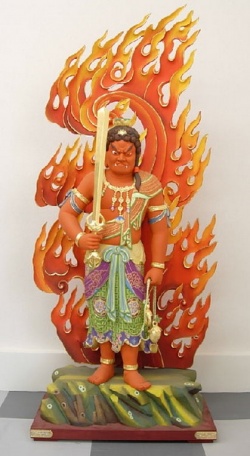The Sutra Spoken by the Buddha on Arya-Acalanatha
The Sutra Spoken by the Buddha on Arya-Acalanatha
Bussetsu Shou Fudou Kyou
An apocryphal text used in Tendai Shugendo
At that time in the Great Assembly, there was one Vidyaraja. This Great Vidyaraja possesses great majestic strength. He has the virtue of great compassion, thus he appears in a bluish-black body. He has the virtue of great meditative stillness, thus he sits on a vajra-rock. He has great wisdom, thus he manifests great flames. He grips the sword of great wisdom to destroy greed, anger, and ignorance. He holds the rope of samadhi to bind those who are difficult to tame. He is the markless Dharmakaya, identical with [all-encompassing] space itself, thus he has no dwelling. His only dwelling is in the minds and thoughts of living beings. The minds and inclinations of all beings are different. In accordance with the minds of living beings, benefit is given and what is sought for is attained. At that time, all in that great assembly heard this teaching and were filled with joy. Faithfully receiving it, they reverently put it into practice.
Chinese: Foshuo Budongmingwangjing
Japan: Bussetsu Shou Fudou Kyou
At that time in the Great Assembly, there was one Vidyaraja. This Great Vidyaraja possesses great majestic strength. He has the virtue of great compassion, thus he appears in a bluish-black body. He has the virtue of great meditative stillness, thus he sits on a vajra-rock. He has great wisdom, thus he manifests great flames. He grips the sword of great wisdom to destroy greed, anger, and ignorance. He holds the rope of samadhi to bind those who are difficult to tame. He is the markless Dharmakaya, identical with [all-encompassing] space itself, thus he has no dwelling. His only dwelling is in the minds and thoughts of living beings. The minds and inclinations of all beings are different. In accordance with the minds of living beings, benefit is given and what is sought for is attained. At that time, all in that great assembly heard this teaching and were filled with joy. Faithfully receiving it, they reverently put it into practice.
Description
In Vajrayana Buddhism, Âcala (alternatively Achala or Acala; "The Immovable One" in Sanskrit, also known as Âcalanâtha, Âryâcalanâtha, Âcala-vidyâ-râja and Caṇḍamahâroṣaṇa, is the best known of the Five Wisdom Kings of the Womb Realm. Acala is also the eighth of the ten stages towards Buddhahood.
Acala is the destroyer of delusion and the protector of Buddhism. His immovability refers to his ability to remain unmoved by carnal temptations. Despite his fearsome appearance, his role is to aid all beings by showing them the teachings of the Buddha, leading them into self-control.
He is seen as a protector and aider towards attaining goals, and temples dedicated to Acala have a periodic fire ritual in devotion to him.
The Buddha Akshobhya, whose name in Sanskrit also means 'Immovable One', is sometimes merged with Acala. However, Acalanatha is not a Buddha, but one of the Five Wisdom Kings of the Womb Realm in Vajrayana as found in the Indo-Tibetan tradition, as well as the Japanese Shingon sect of Buddhism. As Fudô myô-ô, Acala is considered one of the Thirteen Buddhas in Japan.
Acala is typically depicted with a sword for subduing demons in his right hand and a rope for catching and binding them in his left hand. He has a fearsome blue visage and is surrounded by flames, representing the purification of the mind. He is often depicted seated or standing on a rock to show his immovability. His hair commonly has seven knots and is draped on his left side, a servant hairstyle in Buddhist iconography. He is frequently depicted with two protruding fangs. One tooth points down, representing his compassion to the world, and one tooth points up, representing his passion for truth.
It is said he enters into a flame-emitting meditation (Jap: kasho zammai) in which he exudes flames and destroys all karmic hindrances. Because he never yields to obstacles, he is called Fudo (Immovable). His name is inscribed in Siddha, a medieval Sanskrit orthography, on the right side of the Gohonzon as one faces it, signifying that the sufferings of birth and death are nirvana (Jap: Shoji Soku Nehan).
